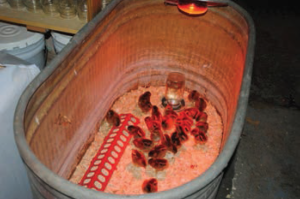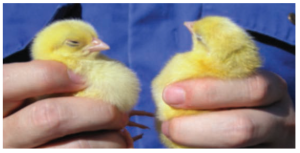Get Your Spring Chicks Off To A Good Start
Click here to view as a pdf: Get Your Spring Chicks Off To A Good Start
By Julie Wadzinski, B.S.
Across the country, more and more people are discovering the joys of maintaining their own backyard chicken flock. For many backyard flock owners, knowing where their meat and eggs come from, coupled with the security and self reliance of having control of their food source is important. Even in many urban settings, city residents find that local ordinances allow for a small flock of chickens. It is not uncommon, for new people being introduced to chickens, to begin their flock by purchasing peeping chicks. When it comes to chick rearing, there are four key management areas to focus on: Temperature, Water, Feed and Lighting.
Temperature:
Chicks cannot regulate their own body temperature until they lose their down. They will rely on the supplemental heat within a brooder to keep warm and draft free for the first few days of their life. Brooders do not need to be expensive; in fact they can be made from a modified stock tank, kiddie pool, or even a cardboard box within a coop. A successful brooder just needs to keep chicks warm, dry and draft free. (See Figure 1)
Figure 1 Homemade Brooders
Brooders should be set up and warmed to 95-97°F prior to chick placement; continue to monitor brooder temperature for the next three days. When monitoring the brooder temperature, take the temperature 3” from the side of the brooder and 3” from the floor. Successful flock managers also take the rectal temperature of a handful of chicks for the first three days; the normal rectal temperature for chicks ranges between 104-106°F.
Monitoring chick movement is the best way to ensure the brooder is draft free and the correct temperature. The chicks should move around in small clusters. If the chicks are crowded to a certain edge, there is likely a draft they are trying to avoid. If the chicks surround the outer edge of the brooder with their wings outspread, they are too hot. The chicks will crowd under the heat lamps if they are too cold. (See Figure 2)
Figure 2 Chick movement within a spot brooder
Water:
Water is the most important nutrient to a chick. Prior to hatching, a chick will ingest the remainder of the yolk. The yolk alone can provide the chick with enough water and nutrients to survive up to 3 days. Two to three days can pass from the time the chick starts hatching, gets processed and is shipped to your home. Much of the nutrients from the yolk absorption will be depleted by the time the chick arrives at your home; highlighting the importance of getting the chicks hydrated and on feed as soon as possible. Some hatcheries will ship an electrolyte packet with the chicks, to add to their water, which aids in rehydrating and getting the chicks on feed. The shipping process puts the chicks under stress, increasing the stress hormone cortisol. Cortisol will suppress their immune function and reduce their appetite; slowing their ability to get on feed upon arrival. Adding Crystal Creek®’s Aloe Juice to the water at a rate of 1 oz per gallon of water will minimize the negative effects of cortisol and bolster their immune system. For the first three to five days it is important to provide the chicks with 2.5 cm of linear water space per bird to ensure each chick has adequate access to the water source.
How to increase chick water consumption:
1. Provide adequate access to water (2.5 linear cm/chick)
2. Provide room temperature water (72° F)
3. Add Crystal Creek®’s Aloe Juice and provided electrolytes to the water
4. Ensure proper brooder temperature so chicks move about the space to find the water source
Feed:
Early chick loss not caused by an infectious disease is commonly termed “starve out” and is the result of inadequate feed/caloric intake during the first 7-10 days of life.
How to prevent “starve out”:
1. Ensure adequate water is available at all times. 100 chicks will consume between 5-6 quarts of water per day (see tips for increasing water intake in new chicks above).
2. Provide a quality chick starter feed that is easily digested and absorbed. The chick starter should be easily accessible with 50 chicks to a starting pan (9”x13”) or 2 cm of trough space/bird for the first month.Family Flock® Chick Starter is formulated to provide the right amount of protein, trace minerals, vitamins and macro minerals to support the rapid growth rate of young chicks. Family Flock® Chick Starter is a crumble that encourages consumption via the right particle size. Family Flock® is formulated with improved trace mineral quality which supports better immune function for healthier, more productive birds. In addition to being formulated with chelated trace minerals, the Family Flock® line of poultry feed contains 100% selenium yeast and increased levels of vitamin E. All of the Family Flock® feeds provide protection to the bird’s digestive tract against common pathogens such as Salmonella and E. Coli. Quality formulation, such as this, results in more nutrient dense meat and eggs.
3. Monitor the birds by palpating the crop of several chicks to make sure that the chicks have found the feed source. To ensure that the chicks have started eating, you can palpate the crop 24 hours after the chicks have been placed in the brooder. A chick that has eaten will have a firm, rounded crop with the texture of the feed. If the crop is round and soft the chick drank water but has not ingested any feed. A chick with an empty crop, that has not eaten or drank 24 hours after placement, is at higher risk of succumbing to starve out. (See Figure 3)
Figure 3 The chick on the left has a full, rounded crop, while the chick on the right has an empty crop
Lighting:
Traditionally there are two types of lighting programs that can be used for starting chicks. One program is called an intermittent lighting program. This program alternates 2 hours of darkness with 4 hours of light for 7-10 days. The theory behind the intermittent program is that the stronger chicks will motivate the weaker chicks when the lights come on. This synchronizes chick activity and makes it easier for managers to identify sick chicks that may need special care.
The other more traditional lighting program revolves around a period of 24 hour lighting for the first 2-3 days. The theory behind 24 hour lighting is that it provides the chicks with more lighting to encourage feed intake.
There are numerous benefits to each lighting program. Ultimately, the decision should be based on which program can be most easily managed and may vary between farms.
Whether you are new to raising chickens or have raised birds in the past you will find that Crystal Creek®’s Family Flock® program has a feed for all stages of your bird’s production. Our knowledgeable staff is here to help you with any poultry question you may have. For the healthiest clutch of chicks call Crystal Creek® today and talk to our knowledgeable staff for recommendations on everything from feed to supportive nutrition.



